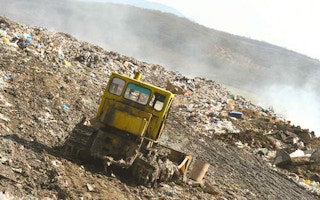Nations including the United States and Sweden are advancing plans to launch a new fund this year to pay for methane emission reduction projects in the developing world.
The countries are aiming to set up a so-called Methane Abatement Facility with pledges of $100 million under the auspices of the World Bank to buy and cancel carbon credits, initially from projects that cut emissions at landfill waste sites.
The aim is to deliver fast-acting cuts to greenhouse gas output blamed for climate change ahead of a UN pact to bind all nations to cut greenhouse gas emissions from 2020.
All countries have agreed that emission cuts must be scaled up before 2020 because the world is currently on track to emit at least 20 billion metric tons (22.046 billion tonnes) of carbon dioxide equivalent more by 2020 than scientists say is needed to stand a chance of avoiding catastrophic climate change.
“We are actively discussing with a group of interested parties, including Sweden, to refine the concept and raise resources,” a spokeswoman for the World Bank said by email on Friday.
The fund will be discussed on April 4 on the sidelines of a Paris meeting of the Climate and Clean Air Coalition, a group of 37 developed and developing nations set up to cut air pollution.
“
Through multi-national auctions that could start by the end of the year, the fund will offer tradeable put options, giving owners the right to sell credits to the fund at a set price
“Sweden has said it is prepared to pledge around $20 million to this. The US and some other countries have also indicated they would be prepared to contribute,” said Caroline Dickson of Sweden’s environment ministry.
Auction process
Through multi-national auctions that could start by the end of the year, the fund will offer tradeable put options, giving owners the right to sell credits to the fund at a set price, according to a World Bank paper on its website dated March 4.
“The strike price will be a function of the specific sectors targeted by each auction round,” said Brice Quesnel, a senior carbon finance specialist at the World Bank.
The paper proposed that the fund could target around 1,200 “stranded” methane projects capable of reducing 850 million tonnes of CO2 equivalent to 2020.
“The Facility will not be restricted to least developed countries … it targets mostly private sector project owners or aggregators rather than governments,” said Quesnel.
The schemes would use existing carbon auditing standards such as the UN’s Clean Development Mechanism (CDM) or voluntary standards such as the Verified Carbon Standard or Climate Action Reserve.
Landfill gas projects represent around 5 per cent of over 8,700 schemes designed under the CDM to generate around 610 million tonnes of emission reductions to 2020, according to researchers UNEP Risoe.
Quesnel, writing on the World Bank’s website last September, cited a study suggesting that a $10 per tonne price could attract enough investment to eventually cut as much as 8.2 billion tonnes of CO2 equivalent worldwide.
Drained investment
The new fund comes at a time when investment in carbon-cutting schemes under UN programmes has slowed as countries wrangle over setting new emission goals under a global pact.
The CDM - the UN’s main carbon market set up by the Kyoto Protocol - has helped to channel almost $400 billion to carbon-cutting projects in the developing world by allowing investors to earn credits they can sell for use in meeting emission targets in richer nations.
But the pipeline of new projects has dried up as prices for CDM credits have crashed to below $1 a tonne from over $20 five years ago, making many schemes unprofitable.
In an effort to prop up the scheme, a handful of European countries have already pledged at least $135 million to pay above-market rates to projects in the world’s poorest nations while offering technical support to help emerging economies such as Brazil and China cut their emissions.

















